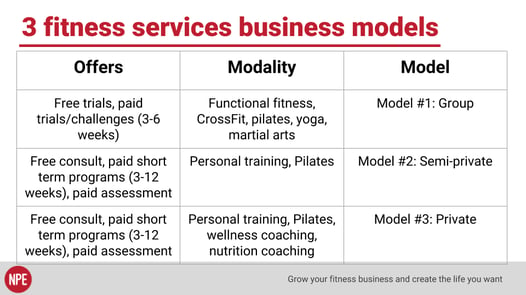If you’re like most newly certified personal trainers, you’re uncomfortable thinking about how to market yourself to generate leads and build up a client base for your business.
That’s because fitness is your passion … and suddenly fitness has become your business.
To stand out from the crowd of personal trainers AND make a professional income with the clients you love working with, you’re going to have to focus your energy in the right direction.
What you need are proven systems and a business plan. Following are the basics you’ll need to generate personal training leads and make yourself stand out:
1. Get clear on your ‘client avatar’ and the problem you want to solve for them
Whether you’re just starting out or you’re not getting the growth you want, you must get crystal clear on whom you want to serve. If you don’t choose your clients, your clients will choose you. You’ll always be reacting to the market. You won’t be able to be strategic with your marketing … because you’re looking for, well, anybody who will show up.
You want to link together very closely a clear client avatar and the problem you want to solve for them. Ask yourself some clarifying questions to get to both:
- Why did you get into this industry?
- What types of problems do you most LOVE solving?
- What goals do you LOVE helping someone achieve?
- Are there clients you DON’T want to work with?
Hint: Usually that’s NOT bodybuilders, grandmas, pro athletes, and overweight kids ALL at the same time. You are looking for someone who is emotionally driven to solve a problem and achieve a goal.
Choose problems you're motivated, inspired, and have competency around solving (pain, mobility, strength, fat loss, etc.). Connect that to the types of clients you most love working with (people who are willing to invest in solving those problems).
Read more: Creating a Customer Persona for Your Fitness Business
2. Align offers to your avatar and business model
Where most fitness professionals go wrong is they mismatch their offers to the problems and clients:
- Their business model doesn’t match “value creation” for their avatar. Someone in their sixties is looking to get out of pain and injury, and the fitness professional throws them in a Crossfit group class on day 1 … with no assessment. That’s a total mismatch about what that person’s problems and goals are, and what program and model and modality will best support them in solving that problem.
- Their offer doesn’t match their business model. Someone is looking to start a fitness program to support improving their challenges with diabetes or lupus, and the fitness professional is marketing a 12-week “get ripped for the beach” body transformation program. That’s not really the reason why they’re looking to start a fitness program nor their primary goal. It’s a mismatch between the offer and what they want and need. Or the fitness professional uses a 7-day free trial that you might use for a group-training program, but that doesn’t work for high-priced personal training. That’s a real mismatch in how we value our time and expertise as professionals.
- Their offer doesn’t align to creating value (solving problems and fulfilling desires) for their avatar. The offer doesn’t move the needle for the person. So if you have someone who needs to lose 100 pounds, and they sign up for my 3-week bikini body challenge, that’s not a good fit. They need a long-term program. A 3-week low-barrier offer (LBO) is a mismatch to the person’s needs.
Often this happens because people don’t align all the parts of their business. You need to know:
- Client avatar problems/desires: know what your client avatar will pay a premium price for to solve or fulfill their problems.
- Modality: the training system or protocols you’ll use to solve the problem (personal training, functional fitness, CrossFit, Pilates, Yoga, martial arts, wellness coaching, nutrition coaching, etc.).
- Model: what you sell, how you fulfill, and how you structure the business to make a profit while solving the problem. Generally that’s group training, semi-private training, or private training, but not all three at the same time.
Only then do you put together your offers. These include free trials, free consults, paid trials/challenges (3, 6, 12 week), and paid assessments (see chart below). The key is alignment and doing this in the right order.

Think you’ve got it right? Then pressure test with these clarifying questions:
- Do my model and modality best solve the problem and achieve the goals that drive my avatar?
- Does my offer align with short term value creation in solving the problem and achieving the goals that drive my avatar?
Look for mismatches in alignment … find and fix them. The better this connects, the easier you’ll find success with engaging the right clients. You pick the right avatar, ensure they are willing to invest in solving that problem or fulfilling that desire, and that your model and modality get the job done. When you’ve got those right, then you must connect the right offer, at the right price point, to start attracting the right people to your business.
3. Use the most effective strategies to connect with new prospective clients
Keep it simple.
Lead generation is like fishing. You start with what fish you want to catch (prospective client). You dangle bait they will like (your offer). You bring the right fishing rod with the right pound-test-strength line (strategy). And then you head to the right pond where the fish are biting (lead source).
Say someone has a serious health issue like lupus or diabetes. Do they scroll through their Facebook feed looking for an ad that will offer a solution to that problem? No way. They go to a health practitioner, naturopath or physical therapist for a reference (and if that’s your avatar, you should be working closely to establish partnerships with each of those practitioners to refer you).
Or they go to Google and search “fitness with lupus in Chicago” or something related. So having good Google ads focused on keywords that matter will make sense for your business. The more serious the problem, the more people will research for the best solution and put time into finding a provider they can trust.
Your progression looks like this (see chart):

Summary
Most fitness business owners dive into lead generation marketing with great energy .... but try to do too many things at once. Their energy is all over the place, and they over-complicate things when what they need to do is focus. Successfully generating leads means you need to get clear on your ideal client, your offers, your strategies, and your lead sources. Stay focused: Schedule the right actions on your calendar, because consistent execution will deliver results.
For additional help and resources, try out the NASM Business Accelerator to learn how to grow your fitness business.

















